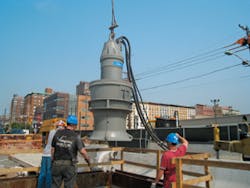Hoboken Puts Flooding Problems to Rest
Hoboken, NJ–the hometown of Frank Sinatra and Cake Boss–is located across the Hudson River from New York City. In its 1-square-mile area, it has more than 50,000 residents and hundreds of boutiques, restaurants, and outdoor cafes, all of which draw large crowds on a regular basis. Hoboken is one of the most densely populated cities in America. Because of its low-lying location on the New Jersey side of the Hudson River, Hoboken has struggled for generations with flooding during extreme wet-weather events and high tides.
The North Hudson Sewerage Authority (NHSA) purchased and took control of the sewer lines within the city in 1998 and has worked diligently to upgrade and modernize the combined sewer collection system. The NHSA–established in 1988 in the wake of an EPA consent order compelling local communities to relinquish control over their failing treatment facilities–serves the communities of Hoboken, Union City, Weehawken, and West New York.
Needing to improve both the safety and the environmental compliance of the century-old sewers and address the worst chronic flooding in the city, NHSA decided to construct a wet-weather pumping station in southwest Hoboken. The pumping station is a 50-million-gallon-per-day system that helps prevent street flooding and, in compliance with New Jersey Pollutant Discharge Elimination System (NJPDES) permitting requirements, eliminates the discharge of solid and floatable materials greater than 0.5 inch in diameter to the Hudson River.
The pumping station was completed in 2011. Along the way, NHSA faced multiple complications presented by the age of the system, parts of which date back to the Civil War; the underground integration of a large pumping station into an urban transportation hub; the rehabilitation of two century-old outfall pipes; and the need to accomplish these tasks within tight quarters immediately adjacent to an active New Jersey Transit Rail Terminal, including two historic buildings, with minimal interruption to the city itself.
NHSA’s consulting engineer, CH2M Hill, led the successful design and construction of the pump station. The H1 Screening and Wet Weather Pump Station project included the construction of a screening chamber using mechanical bar screens to adhere to NJPDES mandates requiring that no solids and floatables be discharged into the Hudson River. The project also involved constructing a wet-weather pump station to alleviate street flooding in the southwest portion of Hoboken, in the H1 drainage area, during storm events that coincide with periods of high tide.
The stormwater pump station itself features two high-performance propeller-style submersible pumps manufactured by Flygt, a Xylem brand, supplied and started up by Pumping Services Inc. (PSI), a Xylem representative located in Middlesex, NJ. The two pumps, one of which is redundant, are installed 30 feet below ground, and each 350-horsepower pump is capable of discharging 50 million gallons per day.
The pump station also has an emergency generator to ensure that it provides continuous service during rain events. Furthermore, the station was architecturally designed to complement the nearby Lackawanna Tower and Hoboken Terminal.
“The efficient Flygt propeller pump with its submersible motor is ideal for stormwater pumping and is used in many major cities throughout the world,” says John Corkery of PSI, who worked throughout the design, installation, and startup of the massive system. Flygt propeller pumps are designed to transport large volumes of water at low heads. The slim profile of these pumps provides a considerably smaller pump station footprint than that of non-submersible pumps.
Flygt submersible propeller pumps operate directly in the pumped liquid and are easily installed and removed from the pump station. No fastening bolts are required. Because the pumps operate in and are submerged in the pumped liquid, they are easy to install and the motors run cooler and more quietly than those of non-submersible propeller pumps. In addition, the pumps incorporate Flygt N-technology, known for its self-cleaning capabilities and sustained high efficiency. The propeller blades feature a backswept design of the leading edge, sweeping away debris from the propeller along the relief groove located in the wear ring. Guide vanes help force debris out of the pump housing by the strong turbulent flow created within. The pump’s small footprint and the resulting compact pump station allow a cost-effective pump solution.
One of the key challenges of the project was the rehabilitation of two 48-inch-diameter, 550-foot-long gray iron outfall pipes that had to remain in service beneath 18 active New Jersey Transit Rail tracks at the Hoboken Terminal. In a concerted effort led by the Authority engineer, the operating team, and CH2M Hill’s design team, a method to clean and structurally line the totally calcified and effectively inoperable outfalls was developed. The challenge required using hand-mining methods by the contractor to remove the vast amounts of calcified soft and hard sediment deposits inside the pipes.
Because of the age and alignment of the pipes–the product of 19th century construction methods–lining the pipes was possible only through the difficult installation of a heavy, railroad-weight-grade, cured-in-place liner. NHSA’s and contractor’s efforts were both innovative and effective in response to the uncommon challenges posed by this project, and those efforts have since been deemed an extraordinary success by NHSA and the city of Hoboken.
The successful completion of the outfall rehabilitation project effectively brought NHSA into compliance with NJPDES permitting requirements for its sewer system and alleviated the street flooding associated with wet-weather events and high tides in low-elevation areas of the city. Employing an effective combination of innovative and traditional engineering methods, NHSA was able to provide the people of Hoboken with an elegant and effective solution to a complex and difficult project.
The capacity of the H1 Pump Station, including the rehabilitated twin 48-inch outfall pipelines, was developed to provide relief from street flooding during a five-year storm event coincident with a high tide. However, on October 29, 2012, the massive 100-year storm Hurricane Sandy made landfall in New Jersey, causing extensive power outages in Hoboken and surrounding communities.
Half the city of Hoboken was flooded, and the city government evacuated two of its fires stations. By October 30, an estimated 20,000 people were stranded in Hoboken, surrounded by water, and the city asked the National Guard for assistance, with rescues beginning the following day. But throughout this tumultuous time and despite the fact that Sandy far exceeded the capacity of the new station, NHSA’s H1 Screening and Wet Weather Pump Station operated around the clock with no interruptions as the Flygt submersible pumps performed flawlessly. NHSA’s executive director, Dr. Richard J. Wolff, attested to the efficacy of the pumping station, saying, “The inundated streets in the southwest portion of the city were cleared of water within 48 hours, at least half the time that it would have taken without the wet-weather pumping station.”
The Hoboken H1 Screening and Wet Weather Pumping Station is a highly efficient, fully modernized system that has been integrated into the surrounding area’s sensitive environment to provide NHSA and the city of Hoboken with a unique and historic key piece of infrastructure that will manage excess wet-weather flows for generations to come.


